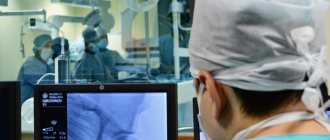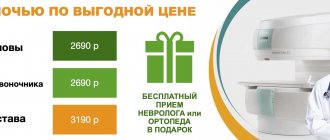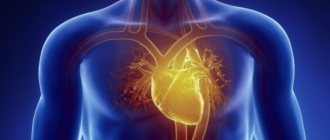Heart defects can be congenital or acquired.
When planning a pregnancy, a woman should identify (or rule out) a congenital heart defect. This will make it possible to take a conscious and balanced approach to family planning and, if pregnancy and childbirth are possible, to prepare for them in advance.
90% of acquired heart defects develop against the background of rheumatism; they can also occur during pregnancy (exacerbation of rheumatism in pregnant women is most often observed in the first three and last two months of pregnancy). Fortunately, there is now a wide range of methods for diagnosing and treating this disease. It is especially important for women suffering from rheumatism to plan a pregnancy. A favorable prognosis for pregnancy is possible if it occurs against the background of an inactive rheumatic process.
Thanks to the improvement of methods for diagnosing and treating heart diseases, many patients with similar diseases, previously doomed to infertility, have the opportunity to carry and give birth to a child.
How to plan a pregnancy with heart defects
Modern medicine has quite effective methods that allow us to calculate the degree of risk associated with pregnancy and childbirth in women with heart defects. With their help, doctors help a woman determine the optimal time for conception or decide the fate of an unplanned pregnancy.
The most important method for assessing the state of the cardiovascular system in case of heart disease is ultrasound of the heart - echocardiography. It is harmless and helps to objectively assess the condition of the cavities, valves and openings of the heart. An auxiliary role in the diagnosis of heart defects is played by electrocardiography (ECG - graphic recording of the electrical activity of the heart), phonocardiography (PCG - graphic recording of cardiac sound phenomena) and Dopplerography (ultrasound, which allows assessing blood flow).
In pregnant women, heart defects account for 0.5 to 10% of all heart diseases. Most often, they have an atrial or ventricular septal defect or patent ductus arteriosus. Women with the above defects usually (with appropriate treatment that compensates for the defect) tolerate pregnancy and childbirth well.
Currently, many women who have undergone heart surgery have the opportunity to give birth. The recovery period after such an operation usually takes 1 year. Therefore, it is in a year that you can plan a pregnancy - of course, in the absence of contraindications (unfavorable results of the operation, the development of diseases that complicate postoperative rehabilitation and reduce the effect of the operation).
It is unnecessary to remind that the question of the possibility of pregnancy and the admissibility of childbirth should be decided individually before pregnancy, depending on the general condition of the woman, the nature of the disease, the severity of the operation, etc. After a comprehensive examination of the patient, the doctor can give a very definite conclusion.
However, even when a woman’s condition is stabilized after surgical (or therapeutic) treatment, pregnancy against the background of an increasing load on the heart increases the risk of recurrence of the underlying disease (a previously compensated defect may become decompensated) - this is another argument in favor of the need for consultation with a doctor and medical supervision before and during during pregnancy, even if the woman herself seems to be healthy and full of strength.
There are severe heart defects with significant circulatory disorders (stenosis of the pulmonary artery, tetralogy of Fallot, coarctation of the aorta, etc.), in the presence of which such dramatic disturbances in the functioning of the cardiovascular system can develop that in 40-70% of cases they lead to the death of the pregnant woman Therefore, with these defects, pregnancy is contraindicated .
Such defects can be inherited, and the likelihood of transmitting the disease to a child is determined in each specific case. (For example, if two or more family members have a heart defect, the likelihood of inheriting it increases.)
In general, the worse the prognosis for the expectant mother and child, the more pronounced the circulatory disorder and the activity of the rheumatic process. In severe heart failure and a high degree of activity of the rheumatic process, pregnancy is contraindicated. However, the issue of continuing pregnancy is decided by the patient and the doctor in each specific case.
Acquired heart pathologies
PPS are formed during human life. Usually these are valvular disorders. Common defects include narrowing and incomplete closure of the aortic, mitral, tricuspid, and pulmonary valves. More than 75% of all cases are aortic lesions.
Cardiopathy can develop due to various circumstances:
- systematic overload of the heart chambers;
- complications of rheumatism, certain infectious lesions, for example, endocarditis;
- mechanical injuries;
- changes of atherosclerotic type, etc.
It is important to detect the problem in a timely manner. Acquired heart defects in the initial stages of development, class 1 and 2 disorders are easily treated. The main thing is to find a good cardiologist.
Pregnancy management
During pregnancy, the load on the cardiovascular system increases significantly. By the end of the second trimester of pregnancy, the blood circulation rate increases by almost 80%. The volume of circulating blood also increases (by 30-50% by the eighth month of pregnancy). This is understandable - after all, the fetal blood flow also joins the maternal circulatory system.
With such an additional load, a third of pregnant women with a healthy heart may experience disturbances in heart rhythm (arrhythmias) and the functioning of the heart valves, what can we say about women with heart defects.
If necessary, drug treatment for heart defects is carried out throughout pregnancy. The goal of treatment is to normalize blood circulation and create normal conditions for fetal development. The question of prescribing drugs and their doses is decided individually, in accordance with the duration of pregnancy and the severity of circulatory disorders.
If therapy is ineffective, surgical treatment is resorted to, preferably at 18-26 weeks of pregnancy.
Echocardiotocography (ultrasound of the fetal heart) is performed periodically throughout pregnancy. Using Doppler ultrasound, uteroplacental and fetal (fetal) blood flow is examined to exclude hypoxia (oxygen starvation) of the fetus.
Naturally, the condition of the mother’s heart is constantly monitored (its methods were described in the previous section).
Often, even with an initially compensated defect, complications are possible during pregnancy, so every pregnant woman suffering from a heart defect should be examined at least three times during pregnancy in a cardiology hospital.
The first time is up to 12 weeks of pregnancy , when after a thorough cardiological and, if necessary, rheumatological examination, the question of the possibility of continuing the pregnancy is decided.
The second time - in the period from 28 to 32 weeks , when the load on a woman’s heart is especially high and it is very important to carry out preventive treatment. After all, a large load on the heart at this time can lead to the development of:
- chronic heart failure, characterized by fatigue, edema, shortness of breath, liver enlargement;
- heart rhythm disturbances (arrhythmias);
- acute heart failure and its extreme manifestation - pulmonary edema and thromboembolism (that is, blockage of the arteries of the lungs with blood clots) in the systemic circulation and pulmonary artery (these conditions pose an immediate threat to life, they must be immediately eliminated in an intensive care unit).
These complications can occur not only during pregnancy, but also during childbirth and in the early postpartum period.
For a child, such maternal circulatory disorders are fraught with a lack of oxygen (hypoxia). If timely measures are not taken, intrauterine growth retardation and insufficient body weight (hypotrophy) of the fetus may occur.
The third hospitalization takes place 2 weeks before birth . At this time, a repeated cardiac examination is carried out and a birth plan is developed and preparations are made for them.
Heart defect is
Defects in the walls, septa, and entire valve apparatus, which negatively affect hemodynamics, clearly characterize and generalize all cardiac defects. Pathologies occur in a chronic form, have a slow course, and can be eliminated through surgery.
The problem is manifested by errors in blood circulation, in which hypoxia of individual organs and tissues is noticeable. Cardiopathy occurs in pediatrics and in adult patients of both sexes; they differ in prognosis, clinical picture and causes.
The myocardium has two halves:
- The first starts and controls the small blood circle. Here the blood from the veins is filled with oxygen particles.
- The second deals with a large circle, nutrition of the whole body.
The central septum is a barrier, so that blood from the veins and arteries does not mix. The heart muscle has 2 ventricles, a pair of atria, and a unique valve system. Together, all these elements are responsible for orderly blood movement in a single direction. Just one defect and the device fails. Unpleasant symptoms develop, oxygen starvation of tissues occurs, and a diagnosis of “heart disease” is made.
Childbirth
The question of the method of delivery is decided individually, depending on how much the defect is compensated by the due date. This could be a vaginal birth with or without pushing (see below) or a caesarean section.
Often, several weeks before giving birth, the increasing stress on the heart worsens the pregnant woman's condition so much that early delivery may be required. It is best if this happens at 37-38 weeks.
The birth plan is drawn up jointly by the obstetrician, cardiologist and resuscitator. Attempts - the period of expulsion of the fetus - represent a particularly difficult moment for the heart of the woman in labor, therefore they try to shorten this period of labor by performing a dissection of the perineum (perineotomy or episiotomy), and in case of stenosis of the mitral valve opening, circulatory failure of any degree, complications associated with impaired cardiac function -vascular system in previous births, - applying exit obstetric forceps.
Caesarean section is performed in the following cases:
- combination of the defect with obstetric complications (narrow pelvis, abnormal position of the fetus in the uterus, placenta previa);
- mitral valve insufficiency with significant circulatory disorders (severe regurgitation - backflow of blood from the ventricle into the atrium);
- mitral valve stenosis that cannot be corrected surgically;
- aortic valve defects with circulatory disorders.
After childbirth
Immediately after the birth of the child and the placenta, blood rushes to the internal organs, primarily to the abdominal organs. The volume of circulating blood in the vessels of the heart decreases. Therefore, immediately after childbirth, the woman is given drugs that support heart function (cardiotonics).
Women with heart defects are discharged from the maternity hospital no earlier than two weeks after birth, and only under the supervision of a cardiologist at their place of residence.
If a woman needs to take medications for a heart defect after childbirth, breastfeeding is excluded, since many of these drugs pass into milk. If after childbirth the heart defect remains compensated and treatment is not required, the woman can breastfeed.
Women suffering from rheumatism should especially carefully monitor their health in the first year after childbirth, when, according to statistics, exacerbations of this disease are quite common.
At-risk groups
Taking into account the causes of fetal pathologies, scientists have identified risk groups. Women from these groups come under the close attention of doctors due to the high likelihood of developing anomalies.
These include:
- women over 35 years of age;
- patients who already have children with congenital pathology;
- women with a history of miscarriage, premature birth, stillbirth or antenatal fetal death;
- couples with a family history;
- patients exposed to radiation or exposed to toxins at work.
In such cases, ultrasound is performed repeatedly - the doctor needs to examine the fetus in detail, evaluate its development over time in order to exclude congenital anomalies.
Recommendations for women suffering from heart defects
Remember that the main reason for the unfavorable outcome of pregnancy and childbirth in those women with heart defects, for whom pregnancy is not contraindicated in principle, is insufficient or irregular examination in the antenatal clinic, the lack of comprehensive pregnancy management by an obstetrician and cardiologist and, as a consequence, the insufficient effectiveness of treatment measures and errors in the management of childbirth and the postpartum period.
Recommended:
- try to prevent unplanned pregnancy;
- consult your cardiologist before pregnancy; find out whether you are able to bear a child and what method of delivery you should prepare for;
- if you suffer from congenital heart disease, be sure (preferably before pregnancy) to consult a geneticist;
- find out what regime you should follow so as not to put yourself and your unborn child at risk, how to eat properly, what physical therapy exercises could help you bear and give birth to a child;
- do not miss your appointments with antenatal clinics and appointments with a cardiologist, complete all prescribed examinations on time;
- do not refuse hospitalization and taking medications - because not only your well-being, but also the health and life of your baby depends on how effectively your heart functions.
Consequences of pathology
It all depends on the form and well-formed medical prescriptions. If you detect the danger in a timely manner, contact a medical professional, undergo a thorough examination, and determine the pathology, you can significantly improve your quality of life. Mild types of lesions are usually not fatal. By taking medications, you can feel quite healthy, be careful, but engage in various types of activities.
It is convenient to obtain accurate information on a specific case from the treating cardiologist-specialist. The doctor will analyze the existing features and give a prognosis and tell you about the possible consequences.
Sources
- Pereira SP., Tavares LC., Duarte AI., Baldeiras I., Cunha-Oliveira T., Martins JD., Santos MS., Maloyan A., Moreno AJ., Cox LA., Li C., Nathanielsz PW., Nijland MJ., Oliveira PJ. Sex dependent Vulnerability of Fetal Nonhuman Primate Cardiac Mitochondria to Moderate Maternal Nutrient Reduction. // Clin Sci (Lond) - 2021 - Vol - NNULL - p.; PMID:33899910
- Ben Abdelaziz A., Bchir A., Ben Salah A., Ben Salem K., Mansour N., Hsairi M., Ennigrou S., Nacef T., Dhidah L., Bellaj R., Mehdi F. Professor Mohamed Soussi Soltani : Leader, Innovator and Researcher in Public Health. // Tunis Med - 2021 - Vol99 - N1 - p.5-11; PMID:33899170
- Saavedra LPJ., Prates KV., Gonçalves GD., Piovan S., Matafome P., Mathias PCF. COVID-19 During Development: A Matter of Concern. // Front Cell Dev Biol - 2021 - Vol9 - NNULL - p.659032; PMID:33898461
- Alexanderson-Rosas E., Antonio-Villa NE., Sanchez-Favela M., Carvajal-Juarez I., Oregel-Camacho D., Gopar-Nieto R., Flores-Garcia AN., Keirns C., Hernandez-Sandoval S. ., Espinola-Zavaleta N. Assessment of Atypical Cardiovascular Risk Factors Using Single Photon Emission Computed Tomography in Mexican Women. // Arch Med Res - 2021 - Vol - NNULL - p.; PMID:33896676
- Bhasin D., Arora GK., Isser HS. Young woman with recurrent pregnancy loss. // Heart - 2021 - Vol107 - N10 - p.821-854; PMID:33893215
- Lee K., Laviolette SR., Hardy DB. Exposure to Δ9-tetrahydrocannabinol during rat pregnancy leads to impaired cardiac dysfunction in postnatal life. // Pediatr Res - 2021 - Vol - NNULL - p.; PMID:33879850
- Richards C., Sesperez K., Chhor M., Ghorbanpour S., Rennie C., Ming CLC., Evenhuis C., Nikolic V., Orlic NK., Mikovic Z., Stefanovic M., Cakic Z., McGrath K ., Gentile C., Bubb K., McClements L. Characterization of cardiac health in the reduced uterine perfusion pressure model and a 3D cardiac spheroid model, of preeclampsia. // Biol Sex Differ - 2021 - Vol12 - N1 - p.31; PMID:33879252
- Song Y., Xu J., Li H., Gao J., Wu L., He G., Liu W., Hu Y., Peng Y., Yang F., Jiang X., Wang J. Application of Copy Number Variation Detection to Fetal Diagnosis of Echogenic Intracardiac Focus During Pregnancy. // Front Genet - 2021 - Vol12 - NNULL - p.626044; PMID:33868367
- Khanna R., Chandra D., Yadav S., Sahu A., Singh N., Kumar S., Garg N., Tewari S., Kapoor A., Pradhan M., Goel PK. Maternal and fetal outcomes in pregnant females with rheumatic heart disease. // Indian Heart J - 2021 - Vol73 - N2 - p.185-189; PMID:33865516
- Kirby A., Curtis E., Hlohovsky S., Brown A., O'Donnell C. Pregnancy Outcomes and Risk Evaluation in a Contemporary Adult Congenital Heart Disease Cohort. // Heart Lung Circ - 2021 - Vol - NNULL - p.; PMID:33863666









